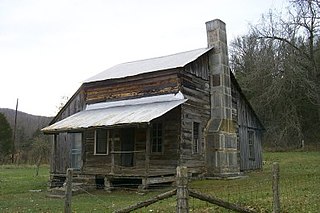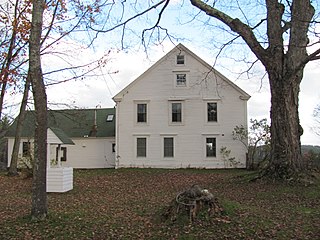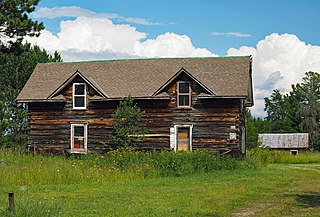
The Thorstein Veblen Farmstead is a National Historic Landmark near Nerstrand in rural Rice County, Minnesota, United States. The property is nationally significant as the childhood home of Thorstein B. Veblen (1857-1929), an economist, social scientist, and critic of American culture probably best known for The Theory of the Leisure Class, published in 1899.

This is a list of the National Register of Historic Places listings in Saint Louis County, Minnesota. It is intended to be a complete list of the properties and districts on the National Register of Historic Places in Saint Louis County, Minnesota, United States. The locations of National Register properties and districts for which the latitude and longitude coordinates are included below, may be seen in an online map.

The Parker–Hickman Farm includes the oldest standing log structure in Buffalo National River. The farm was homesteaded in the 1840s by settlers from Tennessee. It embodies an agricultural landscape with farmstead, extant fields, fencerows, roads, cattle gates, garden and orchard plots, wooded slopes and springs. Unlike most farms in the Ozarks the landscape is remarkably intact and provides insights and evidence spanning portions of two centuries of Ozark history; not randomly chosen, it conveys a feeling of enclosure and exemplifies adaptive use of topography. Among farms of its kind in Missouri and Arkansas it was once typical but now survives as a rare baseline example for Ozark yeomanry farms of mixed economies. Parker–Hickman was an agricultural enterprise that continuously operated until 1982 from a farmstead which exemplifies the entire period, and a rare one for the Ozarks since it survives. Clustered around the farmstead are several structures: barns, sheds smokehouse, privy, fences, stock feeders and house that represent a cross-section of rural vernacular architecture still in their original location.

This is a list of the National Register of Historic Places listings in Clay County, Minnesota. It is intended to be a complete list of the properties and districts on the National Register of Historic Places in Clay County, Minnesota, United States. The locations of National Register properties and districts for which the latitude and longitude coordinates are included below, may be seen in an online map.

This is a list of the National Register of Historic Places listings in Isanti County, Minnesota. It is intended to be a complete list of the properties and districts on the National Register of Historic Places in Isanti County, Minnesota, United States. The locations of National Register properties and districts for which the latitude and longitude coordinates are included below, may be seen in an online map.

The Alex Seitaniemi Housebarn is a rare surviving example of a log housebarn constructed by Finnish Americans, located in Waasa Township, Minnesota, United States. It was built in two stages from about 1907 to about 1913. The housebarn was listed on the National Register of Historic Places in 1990 for its national significance in the themes of architecture and European ethnic heritage. It was nominated for being an example of a rare building type and for embodying the settlement and traditional log architecture of rural St. Louis County's Finnish American farmers.

The Charles Spangenberg Farmstead is a historic farm in Woodbury, Minnesota, United States, established in 1869. The three oldest buildings, including an 1871 farmhouse, were listed together on the National Register of Historic Places in 1978 for having local significance in the theme of agriculture. The property was nominated for being one of Washington County's few remaining 19th-century farmsteads.

The David Hanaford Farmstead is a historic farm in Monticello Township, Minnesota, United States. It was first settled in 1855 and features a farmhouse built in 1870 and a barn from around the same time. The farmstead was listed on the National Register of Historic Places in 1979 for having local significance in the themes of agriculture and exploration/settlement. It was nominated for being "an excellent example of an early Wright County farmstead developed by a pioneer family from New England."

The Zachariah Spaulding Farm is a historic farmstead on South Hill Road in Ludlow, Vermont. With a history dating back to 1798, it is a well-preserved example of diversified 19th-century farmstead, made further distinctive by the remains of a sauna, the product of ownership by two Finnish families in the 20th century. It was listed on the National Register of Historic Places in 1993.
The David N. Peet Farmstead is a historic farmstead in Deerhorn Township, Minnesota, United States. It was listed on the National Register of Historic Places in 1980 for its local significance in the theme of agriculture. The listing consists of four contributing properties: the 1901 barn, 1902 Queen Anne farmhouse, 1912 wood-hoop silo, and 1920 windmill. The property was nominated for being one of Wilkin County's best exemplars of the prosperity achieved by some of its late-19th-century farmers. Peet acquired the property in 1881.

The Alfred R. Voss Farmstead is a historic farm in Rosendale Township, Minnesota, United States. It was established in the early 1880s by Alfred R. Voss (1860–1952) and grew to become one of the largest private farming operations in late-19th-century southern Minnesota. Its stock barn, built 1893–1896, is one of the largest and most elaborate barns in the state. The farm was listed on the National Register of Historic Places in 1988 for its local significance in the themes of agriculture and architecture. It was nominated for its size, its unusually large and impressive buildings, and its associations with Voss, a land speculator instrumental in the settlement of Watonwan County and later one of the area's most prominent farmers.

The Anton Gogala Farmstead is a historic farmstead in Krain Township, Minnesota, United States. For over a century it remained a small-scale dairy farm operated by a Slovene American family, and contains traditionally constructed buildings and structures dating back to 1875, including several built of logs. The farm was listed on the National Register of Historic Places in 1982 for its local significance in the themes of agriculture, architecture, and exploration/settlement. It was nominated as the best surviving illustration of Stearns County's settlement-era farmsteads of the late 19th century, and for the Gogala family's key role in establishing the Slovene American community of St. Anthony a mile to the north.

The Waino Tanttari Field Hay Barn is a barn built with traditional Finnish log construction in Waasa Township, Minnesota, United States. It was built in 1935 by Finnish American farmer Waino Tanttari, and stands in isolation a quarter mile from the main cluster of buildings on the farmstead. The Tanttari Barn was listed on the National Register of Historic Places in 1990 for its state-level significance in the theme of agriculture. It was nominated for reflecting the successful conversion of northeastern Minnesota's cutover forests into farmland by late-19th and early-20th-century Finnish American settlers.

The Anna and Mikko Pyhala Farm is a historic farmstead in Embarrass, Minnesota, United States, now preserved as a visitor attraction. It was established by a Finnish-American family in 1909 and includes seven surviving buildings, including several constructed with traditional Finnish log architecture, and the ruins of a prior settler's log cabin dating to around 1895. The farm was listed as a historic district on the National Register of Historic Places in 2003 for its state-level significance in the themes of agriculture, architecture, and European ethnic heritage. It was nominated for being one of St. Louis County's best examples of a Finnish-American farm with log architecture, and for its association with Finnish immigration to northeast Minnesota and the conversion of its cutover forests into productive farmland.

The Erick and Kristina Nelimark Sauna is a historic Finnish sauna in Embarrass, Minnesota, United States. It was built around 1930. The sauna was listed on the National Register of Historic Places in 1990 for its state-level significance in the themes of agriculture, architecture, and European ethnic heritage. It was nominated for reflecting the area's settlement by Finnish American farmers and their use of traditional log construction.
The Mike and Mary Matson Farmstead is a historic farmstead in Embarrass Township, Minnesota, United States. It was established by a Finnish immigrant family around 1900 and includes five surviving buildings constructed with traditional Finnish log architecture. The farm was listed as a historic district on the National Register of Historic Places in 1990 for its state-level significance in the themes of agriculture, architecture, and European ethnic heritage. It was nominated for its association with the Finnish settlement and conversion of St. Louis County's cutover woodland into productive farmland, and for exhibiting their use of traditional log architecture.

Listening Point was the private retreat of conservationist Sigurd F. Olson (1899–1982) on Burntside Lake in Morse Township, Minnesota, United States. Olson acquired the property in 1956, then purchased a log cabin and a log sauna elsewhere that he had dismantled, moved to Listening Point, and reassembled. In 1998 the Listening Point Foundation was organized to preserve the property as an open-air museum to Olson.
The Adolph Levin Cottage is a historic vacation property on Kabetogama Lake in St. Louis County, Minnesota, United States. It contains a log cabin built in 1937 for two friends, Dr. Adolph Levin and George Plager. A metal water tank and the surrounding landscape are also contributing historic features. It is now preserved within Voyageurs National Park as an example of the early tourism and recreational properties in the area. In 2011 the property was listed on the National Register of Historic Places for its significance in the themes of architecture and entertainment/recreation. It was nominated for being a representative early-20th-century lake retreat, and for the rustic architecture and traditional Finnish construction of the cabin.

The Gregorius and Mary Hanka Farmstead is a historic farmstead in Embarrass Township, Minnesota, United States. It was established by a Finnish immigrant family around 1910 and includes four surviving buildings constructed with traditional Finnish log architecture. The farm was listed as a historic district on the National Register of Historic Places in 1990 for its state-level significance in the themes of agriculture, architecture, and European ethnic heritage. It was nominated for reflecting the successful conversion of St. Louis County's cutover forests into productive agricultural land by Finnish immigrants, and their use of traditional log architecture.

The Elias and Lisi Aho Farmstead is a historic farmstead in Waasa Township, Minnesota, United States. It was established by a Finnish immigrant family and includes five surviving buildings constructed with traditional Finnish log architecture from 1902 to 1907. The farm was listed as a historic district on the National Register of Historic Places in 1990 for its state-level significance in the themes of agriculture, architecture, and European ethnic heritage. The Aho Farmstead was nominated for reflecting the successful cultivation of northeastern Minnesota's cutover forests by Finnish American settlers and their use of traditional log architecture.




















